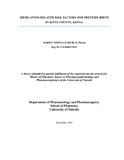| dc.description.abstract | Introduction: Premature infants contribute substantially to infant morbidity and mortality
especially in low resource areas. Understanding the factors that contribute to pre-mature
labour in these areas would greatly influence infant morbidity, mortality and reduce
paediatric healthcare costs.
Objective:To investigate the use of herbal remedies, self-medication and prescription
medications in pregnancy as risk factors for preterm birth in Kitui County among the
immediate post-partum mothers.
Methods: An unmatched case control (1:4) study was conducted in Kitui and Mwingi
District Hospitals in Kitui County. A total of 560immediate postpartum mothers were
sampled of which 107 were mothers with preterm birth (Cases) whereas 453 were mothers
with term birth (Controls). Retrospective review of medical records was conducted to collect
data pertaining to medical history and use of prescription drugs during pregnancy.
Structured questionnaires were administered to mothers to collect data on demographic
characteristics, socio-economic status, self-medication practices and use of herbal remedies.
Data was analyzed to describe the distribution of demographic variables between cases and
controls using the Pearson Chi square test. Logistic regression was used to test for
association between various predictors such as self- medication, use of herbal remedies and
prescription drugs and the main outcome variable, pre-term birth. Multivariate modelling
was used to identify the risk factors for preterm birth while controlling for confounding.
Results:Predictors of preterm birth were: Herbal use in the 1st trimester lasting two to five
days (OR=11.10 [4.34-28.41], p<0.01), herbal use in the 1st trimester lasting six to 10 days
(OR= 44.87 [4.99-403.87], p<0.01) and herbal use in the 2nd trimester for six to 10 days
(OR= 16.43 [4.53-59.57], p<0.01). Self-medication with the following medications in the 1st
trimester for 2 to 5 days: Chlorpheniramine (OR=2.64 [1.22-19.65], p=0.012), Paracetamol
(OR=1.34 [1.09-6.73], p=0.043), Amoxycillin (OR=5.72 [1.60-20.84].
Factors were associated with lower risk of preterm birth: Amoxicillin prescribed in the 1st
trimester (OR=0.09 [0.01-0.66], p=0.043), ferrous sulphate, 2nd trimester for more than 31
days (OR=0.22 [0.13-0.35], p<0.001), folic acid from 2nd trimester for more than 31 days
(OR=0.20 [0.12-0.34], p=0.02) and FDA category A medications (OR=0.27 [0.07-0.42],
p=0.001).
Conclusion and Recommendations: Use of herbal remedies and self-medication in
pregnancy is common among the women in Kitui County and it is a major risk factor for
preterm birth. Prescribers should be sensitized on safe medication use in pregnancy and
prompt management of maternal infections. Folic acid and ferrous sulphate supplementation
throughout pregnancy should be strengthened. | en_US |
| dc.description.department | a
Department of Psychiatry, University of Nairobi, ; bDepartment of Mental Health, School of Medicine,
Moi University, Eldoret, Kenya | |



